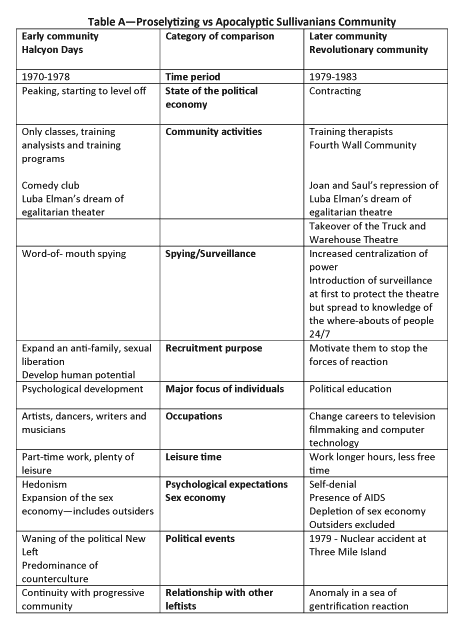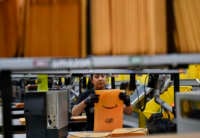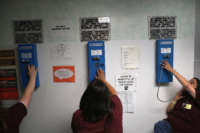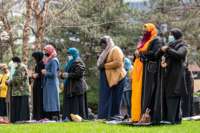 Photo Image: FilmDaily
Photo Image: FilmDaily
Orientation
My Purpose
A few months ago, I wrote an article titled “Political and Spiritual Cults“. My purpose was to show the commonalties among all cults, whether they are political, spiritual or psychological. In this article I want to narrow the focus to discuss a left-wing psychological cult, the Sullivanians, a countercultural organization that made its mark on the Upper West Side of New York City between 1970 and the early 1990s. Why bother to do this? Because as a socialist I have to face that any socialist organization I join, whether it be social democratic, Leninist or even anarchist has the potential to become a cult. The more we know about the conditions under which cults emerge, the more we can combat them.
Overcoming Media Biases Against Cults
When mass media compares cults members to the general population, cult members are portrayed as:
- Mentally unstable
- Less educated
- Lonelier
- From the poor and working-class backgrounds
- Physically intimidated into joining
- Brainwashed
- Drawn from criminal elements
- Less moral as people
Research has shown none of this to be true.
Plan of the Article
For the most part I will be following the architecture I built in my previous article, including what is a totalistic institution; the ten characteristics of cults; the stages cults go through; the mechanisms of control in each stage; why people stay; what kind of qualities the leaders have and what is the impact of leaving on cult members.
I will be adding a short section on the theoretical assumptions of the Sullivanians at the beginning. For each of these units I will say something about how it applies to the Sullivanians. Besides my article, I will be referring to two books on the Sullivanians: Amy Siskind’s sociological analysis, The Sullivan Institute/Fourth Wall Community: The Relationship of Radical Individualism and Authoritarianism and a book by a participant, Artie Honan How Did A Smart Guy Like me….For my general understanding of cults, I owe the most to Margret Singer, Janja Lalich, Joel Kramer and Diana Alstad.
Theoretical Assumptions
The Sullivanian Institute was a spin-off organization that broke away in 1957 from the work of Harry Stack Sullivan. Sullivan was sensitive to the social side of psychological dynamics and among other insights blamed the nuclear family for the formation of the ideal capitalist consumer. Both Dr. Jane Pearce and Saul Newton took these criticisms of the nuclear family much further. In 1963, Pearce and Newton coauthored a book called Conditions of Human Growth. In that book they identified the family as socially isolating the individual from developing healthy relationships with friends, especially in adolescence and adulthood.
Open-ended friendships, both sexual and otherwise, were the way out of the infantilization of the nuclear family and the road to maturity. For them, friendships are the first potential of experience of love between equals. A big part of therapeutic work was to get their patients to expand their friendships as they withdrew from their families. Newton and Pearce considered the desire for the security of exclusive relationships among their patients to be a neurotic symptom. In fact, one of the first things on the agenda of the Sullivanians therapists was to separate the patients from their parents. On the whole the two foundation stones of the Sullivanians community were:
- To break from their family of origin
- To have non-monogamous sexual relations among friends
What is a Totalistic Institution?
Calling an organization a cult has more to do with how an organization is run than what people believe. Cults are a subcategory of organizations which includes mental health institutions, prisons, army barracks, orphanages, and religious institutions such as monasteries. As opposed to this, in what Erving Goffman calls “pluralistic institutions”, people come and go as they please in and out of various institutions throughout the day as they go from playing one role to another. Within each institution, the group dynamics and power relationships vary. An individual can have great control in one area and little control in another. What produces critical thinking within the individual is the habit, whether conscious or unconscious, of comparing one institution to another, each with their strengths and weaknesses.
In totalistic social formations, all institutions are rolled into one. Economic exchanges, livelihood, sacred beliefs, political dynamics, living situations and sexual encounters are all concentrated within a single institution. In the more extreme institutions like prisons or in the military, working and play activities are done all at the same time, in the same place with uniform expectations. Boundaries between inside and outside are rigid. The authorities are centralized and there is little room for feedback. There are surveillance systems, spying and little privacy, and this breeds insecurity and paranoia.
Sullivanians as a Total Institution
The Sullivanian community was divided into four tiers. The four therapists at the top were Saul Newton, Joan Harvey, Ralph Klein and Helen Moses; a secondary tier of therapists in training; a third tier of psychotherapy patients and lastly, community members who were friends of the people in the first three tiers. When the Sullivanians morphed into the Fourth Wall Theatre community in 1977, the fourth tier were people living in Manhattan who came to see the plays, often from poor areas of the city. The biggest factor that made the Sullivanians a totalistic institution was the collapsed boundaries between the tiers. Members of all tiers were invited to have sex with each other, including therapists with clients, clients and those in therapy training. Sleeping alone was considered an interpersonal failure. Furthermore, the therapists ignored confidentiality and talked openly about the problems of their patients. The most important people – the therapists – knew everyone else’s business and encouraged others to be spies to report on any dissatisfactions anyone had with the leadership. This led to mistrust among people in the second and third tiers as well as paranoia.
The Sullivanians were not as rigid as a prison or an army barracks. Community members worked at different jobs and they lived in different apartment buildings. However, all households occupied most of an apartment building and each household apparently consisted only of members of the Sullivanian community. These households made enough money to hire people from the outside to cook, clean and babysit. House members had regular meetings in which they talked about household problems but also about their lives. Members also knew each other’s weaknesses and these weaknesses got back to the leadership in one way or another.
The dependency of community members on the leadership ran deep. Therapists in training were dependent on leadership economically to provide them with referrals. People were dependent personally for their identity through therapy. Interpersonally they played together, lived together and in the 1980s, did political work together. All this supported the authoritarian control by the leaders and made the Sullivanians a totalistic institution.
Ten Characteristics of Cults
From my previous article on cults, I named ten characteristics.
- It emerged out of a political, economic or ecological crisis.
- It recruited young adults between 17 and 24 of middle-class and upper middle-class origins who were likely to be undergoing some developmental crisis in their personal lives.
- It has an authoritarian, charismatic leader.
- It has a revolutionary, dualistic ideology.
- It possesses a social-psychological array of tools for luring in new members and sustaining their commitment.
- It lacks mechanisms for critical feedback from the membership.
- It requires a small group of lieutenants to isolate and keep atomized the membership through spying so that no coherent opposition can form.
- It develops rituals, myths and celebrations that allow the group to mark time.
- It demonizes outside groups that are in competition with the cult.
- It has rigid, terrorized boundaries that make it extremely difficult to leave.
Sullivanians’ Characteristics of Cults
It is not true that the Sullivanians cult emerged as a reaction to a political, economic or ecological crisis. In the late 1960s and early 1970s, the economy was not contracting. It was possible for community members to work at low paying jobs in the arts, have leisure time and still make the rent, especially because of group living. However, the decline of the Sullivanians community in the 1980s was definitely connected to contracting economic conditions where rents skyrocketed and jobs in the arts shrank. AIDS and the nuclear reactor meltdown at Three Mile Island added to the group paranoia.
The Sullivanians did appeal to upper middle-class adults. They weren’t in any serious psychological crisis. They were relatively healthy adults who were attracted to an alternative lifestyle including art. music, theatre and dance. Sexual exploration was part of the counterculture and not unique to the Sullivanians. In Saul Newton they had an authoritarian working-class leader who was once a member of the Communist Party and claimed to have fought in the Spanish Civil War. Both men and women in the community agreed he was charismatic. Newton was also erratic and explosive and most members were scared of him. There were no institutionalized feedback mechanisms for criticizing the leadership. Complaining behind his back was dangerous because of surveillance and could easily get back to the leaders.
Although Newton was either a Stalinist or a Maoist, in the first nine years of the community, he was not heavy-handed politically. It was in the descendent phase when the nuclear meltdown occurred, the AIDS epidemic spread and Yankeedom had become more conservative in the 1980s that his Stalinist or Maoist politics became more hard-edged. Relations between the Sullivanians and other leftists became increasingly hostile, and their political ideology became more dualistic and sectarian. Here is where the characteristic of the demonization of outsiders took place.
The psychological array of tools for drawing people in and holding them was pretty straightforward. In all cults, sex is used to control people. However, in most cults sex flows one way, from the members to the leaders. Among the Sullivanians sex among members was immediate and expected. Secondly, unlike other cults, women were encouraged to have more than one partner at a time. Besides immediate and sustained sex for both men and women, there was the opportunity to work with therapists on their problems and to do so for a low fee, compared to the much higher going rate. Thirdly, friendships were made quickly and developed through household living arrangements. Fourthly, the Sullivanians were very supportive of the members developing their creativity. Siskind points out that many of them became famous in the arts, filmmaking, and dance. The Sullivanians were also a utopian community, so joining it helped people to feel that they were a special group, superior to others, in addition to being part of a movements which was going to overthrow capitalism.
Symbolism and ritual were a strong part of the Sullivanians community. They played hard together at parties and vacations, but this was all secular enjoyment. There was no celebration of revolutionary holidays or the singing of the Internationale, as we might expect of an aspiring socialist community. Neither was there a dramatic change of identity based on change of hair or clothes that I found.
Stages of Cults
As I said in my article Political and Spiritual Cults:
In their book, The Guru Papers, Joel Kramer and Diana Alstad identify two stages of cults: the proselytizing stage and the apocalyptic paranoia stage.
In the proselytizing ascendant stage, the guru sees the possibility of realizing his ambitions. The group is touted as being at the cutting edge of new knowledge. Outsiders are welcomed although they are treated with a kind of benign superiority. In the ascendant phase, the guru rewards the enthusiasm of his followers and grants them positions which have opened up within the hierarchy. The tone of the community is celebratory. The guru is accessible to the public and is charming and playful. In terms of the recruitment, this is the “honeymoon phase”. The focus is to expand the organization and the emphasis is on the present.
The apocalyptic, paranoiac, decadent phase is when the numbers of recruits have leveled off and explanations need to be found. The public is now seen as too stupid and blind to acknowledge the merits of the cult. In the declining stage, the message becomes pessimistic, with a doomsday “I told you so” tone. Outsiders cease to be welcomed in a spirit of satisfying their curiosity. Rather they are seen as enemies out to destroy the organization. Part of the descendent phase also involves the guru making more grandiose claims while promising to invoke occult power. The membership begins to have doubts.
Sullivanians’ Stages of Cults
The Sullivanians definitely went through these stages. Siskind, in her sociological analysis of them, calls the proselytizing phase the “Halcyon Years” from 1969-1978. Siskind calls the apocalyptic phase “the Revolutionary period of 1979-1983. Between 1984 and 1992 there was a steep decline in membership. In the first period the emphasis was on the psychology of the individual and their full development, including taking classes and the practice of the arts. The full enjoyment of life through sex, friendship, creativity and community was all supported. They also had a comedy club run by a very talented member, Luba Elman who was also responsible for early theatrical productions which later turned into the Fourth Wall Theatre Company. Between 1970 and 1974 the Sullivanian community grew at a steady rate of 100 new members a year, culminating at a peak of 400 in 1974. Political relations with other leftists had some tension but that did not stop cooperation in large protests.
There were four shock waves which were scattered across the landscape of the Sullivanian community between 1977 to 1983 that turned it from growing, hopeful community into a more stagnant, paranoid and isolated community. The first was the driving out of Luba Elman as the organizer of the Fourth Wall Repertory Company and her replacement by therapist turned playwright and actress, Joan Harvey. Both she and her partner Saul were dictatorial in their expectations of the members of the stage crew and everyone else in the Fourth Wall community.
Another very dramatic event was the Fourth Wall takeover of the Truck and Warehouse Theatre. The previous company refused to leave the building although the lease was up. They were forced out in an orchestrated attack, with waves of Fourth Wall people invading the building. Some took over the stage sets, rebuilt them with the carpentry and electrical skills of the Fourth Wall community. Two hours after the initial takeover, 160 more members came to support the takeover and guard the building. Then they set up an elaborate security system to guard the building. The violent nature of the whole process must have affected the moral of people. Artie Honan, one of the chief organizers of the takeover, said: ”Looking back, I feel that this was a senseless act of violence. Something I wouldn’t have done if I hadn’t been taking direction from Saul. (What’s a Smart Guy Like Me…) I doubt he was alone in these sentiments. Later he said I was preoccupied about having to organize security coverages …I had no time to reflect on the experience or to think about how it ran against the grain of my values. Lack of time to think is characteristic of all cults.
A third major event was the Three Mile Island nuclear accident in 1979. This spread fear in the community. It led to a panic in which 200 community members en masse fled to Florida to avoid radiation. This event turned the Sullivanians into an explicitly political community as Saul’s Maoist orientation came to the fore. House meetings went from every day discussions about household and personal problems to political book readings and discussion groups. It was in this period that Saul implemented a Maoism anti-intellectual campaign in which community members would renounce their class background in group self-confession circles.
A fourth major event was the AIDS crisis of the early 1980s. This directly impacted the size of the community and the sex-economy of the organization. The Fourth Wallers were naturally wary of having sex with outsiders and limited the sexual activity to the already existing members. Since, on average, the women outnumbered the men two to one, the shortage affected the women more than the men. There was even a Male Chauvinism campaign within the community to force the men to have sex with women who didn’t have partners! Please see Table A for a contrast between the two stages within the Sullivan community

Characteristics of Sociopathic Leaders
In their book Take Back Your Life: Recovering from Cults and Abusive Relationships, Janja Lalich and Madeleine Tobias identify fifteen characteristics of a sociopath that could apply to a cult leader. Here they are:
- Glibness and superficial charm
- Conning and maneuvering
- Grandiose sense of self
- Pathological lying
- Lack of remorse, shame or guilt
- Shallow emotions
- Incapacity to love
- Sensation seeking
- Impulsivity and lack of behavioral control
- Early behavior problems with juvenile delinquency
- Scapegoating
- Promiscuous sexual behavior and infidelity
- Erratic work history of fits and starts
- Materialistic lifestyle
- Criminal and entrepreneurial versatility
Saul Newton as a Sociopath
As repulsive as Saul Newton might be to you and to me, he did not have all fifteen characteristics of a sociopath. I will begin by eliminating the characteristics he did not possess. We know very little of his history, so we don’t know anything about whether his teenage behavior might be categorized as juvenile delinquency or whether he had an erratic work history. From my reading I did not find instances of sensation-seeking. He put members in the Sullivanians community in risky situations, but he seemed to be sure that he and any of his wives were well-protected. It would be unfair to characterize him as having shallow emotions. He had problems controlling his anger, as in beating his wives. There is nothing I’ve read that indicated that Newton showed any deep emotion but anger. It is reasonable to say he was emotionally repressed, rather than being shallow.
Criminal and entrepreneurial creativity in cults usually means if one cult group fails and goes bankrupt, the leader wheels and deals and repackages himself with a new name and organization as Werner Erhard did. As far as I know, Saul Newton did not do this. He stuck with the Sullivanian community all his life. Lastly, a “materialistic lifestyle” is a very vague term. How many cars, boats, planes and houses does a leader have to possess to qualify as being materialistic? From my reading, I would classify Newton as upper middle-class, akin to a doctor, lawyer or architect living on the Upper West Side of New York City. He and his wives had their own chefs, childcare providers and shoppers. He owned a brownstone building. Newton lived well, but he didn’t have seven Cadillacs, as Rajneesh had. He did not own any boats or planes, nor did he buy other buildings and deal in real estate. He did not have the lifestyle of L. Ron Hubbard, Reverend Moon or Werner Erhard.
However, Newton had all the remaining characteristics of a sociopath big-time. He had superficial charm, and as I said earlier, both men and women characterized him as charismatic. He clearly was conning and manipulating the community all his life. He got them to take over a theatre building, told them who could and couldn’t date and set up an elaborate surveillance system for tracking people while convincing the members to do all the work. He maneuvered with Joan Harvey to oust Luba Elman from the Fourth Wall community and put themselves in the leadership position. He seemed to be a pathological liar, meaning he lied so much he lost track of the boundaries between truth and falsehood. There is no indication in either of the books I read that he has the slightest regret or remorse for anything he did. Neither were there any examples in which Newton claimed to love anyone. He was not loved by community members, but feared. In a small funeral gathering in 1992 not a single member of the Sullivan community showed up.
Newton definably had a grandiose sense of himself. What kind of person would have put himself at the head of a psychotherapy organization with no degree in the field or even having been in therapy himself? He was almost compulsively promiscuous. He had no problem asking his female patients for sex as part of the sessions. At the end of his life when he was suffering from dementia, he continued to see clients even when his memory was failing him. Newton was clearly impulsive (at least around getting angry) and could not control himself. However, in other situations he was extremely deliberative as he plotted and schemed to manipulate community members. Lastly, he was always blaming community members when things didn’t go right. He showed no power of self-reflection in seeing how his behavior was partly responsible for anything.
Reasons People Stayed in the Community
Why do People Stay?
Lalich and Tobias lay down the following most common reasons people stay in cults:
- Attachment to new beliefs
- Cognitive dissonance
- Entrapment
- Peer pressure
- Exhaustion from overwork allows little time for objectivity or self-reflection
- Burned bridges separate members from their past
- Being ridiculed and called names by cult members is very painful
- Fear for your life
- Guilt and embarrassment over having participated in the group to begin with
From the two books I’ve read about the Sullivanians, I would say virtually every one of these psychological conditions were operating. In the early years, the major belief centered around a conviction that their nuclear family was the major part of their problems. Giving up their belief would mean facing they were dupes who then burned their bridges and hurt their families badly. It would definitely cause cognitive dissonance. Community members were clearly entrapped. Most spend anywhere between 5 and 20 years in the community, forging deep friendships. They spent hundreds of hours in therapy and in the last years of the community, that was not cheap. For many, their livelihoods were dependent on the community and their living situations were all tied together. It is completely understandable they would not want to cut their losses.
There was a great deal of peer pressure to stay in the group. It was difficult to think clearly about whether or not to leave when they could not easily discuss openly their reservations about staying. They could never be sure if what they said would get back to the leadership. In addition, by the early 1980s, the economy was contracting, requiring members to work longer. Also, Newton was becoming increasingly demanding of members to be available for work on the Fourth Wall community. As Artie Honan says many times in his autobiography, there was little time to reflect on the big picture. Most were like frogs in slowly boiling water. They couldn’t see what was happening to them.
Unlike other leftist cults, there didn’t seem to be a great deal of name calling, but Saul Newton was brutal about getting rid of any community member he felt was too much trouble and, perhaps more painfully, community members executed his wishes. People were kicked out of the community quickly, often told they had 24 hours to leave their group housing situations. In at least one instance a person’s things were thrown in the street. Ex-members were shunned and ignored in public and the Upper West Side of New York is not a place to easily find anonymity.
Saul Newton was a violent man. He beat his wives and occasionally publicly punched a few of the men in the community. The violence he used in orchestrating the takeover of the theatre was probably never forgotten by anyone. When one of Saul’s psychological proteges decided to leave, upon Newton’s instruction he was followed, grabbed from behind and held over the subway tracks.
If members decided to leave, they had little in the way of a support system. Their families were heart-broken, angry and some members were disowned. The road back was unknown, lonely and full of doubt. There was no recovery groups from cult in those days. I don’t really know that the Sullivanian community felt a sense of guilt upon leaving the way members of other cults might. If a member got into the cult early, in the good days of the first seven years, those memories must have been breath-taking, intense and not easily forgettable compared to whatever normal life followed. It was the period from the early 1980s on they might have felt regretful about.
Aftermath for Cult Members
In their book Cults in Our Midst, Margaret Thaler Singer and Janja Lalich identify five major areas of life ex-cult members have to deal with:
- Practical everyday life
- Emotional volitivity
- Cognitive inefficiencies
- Theoretical instabilities
- Lack of a social network
How Ex- Sullivanians Members Managed Their Lives in The Aftermath
Practical, everyday life
The two books I read on this subject do not have much information about how group members managed after the community broke up. Most of what follows will be what I would call reasonable speculation. In the area of everyday living, I believe the Sullivanians did better than ex-members of other cults. For example, Sullivanians had to find work to support themselves while in the cult and they succeeded in landing jobs in the arts or doing technical work. While ex-members who became therapists were dependent on referrals, this was not a community that was totally dependent economically. The same was true about managing money and finding an apartment. Members had practice in doing these things even when in the cult. While the Sullivanians were not provided with their own medical and health care, as upper middle-class urbanites they would not go without health and medical care as many members of other cults did. All this doesn’t mean they did not suffer. But compared to other cults, the climb back up might not have been as steep.
Emotional volatility
In terms of emotional volatility, I suspect the Sullivanians were more like other cults in that members suffered from PTSD, insomnia and dissociation at times. I don’t think difficulty concentrating or flashbacks were part of the psychological processes they had to constantly fight off because there were not that many bad experiences. I don’t believe a loss of a sense of humor was a psychological condition. Membership in households provided opportunity for play and laughter. It wouldn’t take much to bring them back. Depression over loss of the Sullivanian community and its vision must have been great. Before the community as a whole broke up, Saul‘s treatment of those who left would give them every reason to fear for themselves and their loved ones.
Cognitive inefficiencies
Many members of other cults have trouble thinking critically when they leave. Especially in spiritual cults which place a great deal of emphasis on meditation, and other altered states of consciousness, where critical thinking is frowned upon. Some young members of cults never learned to think critically. They simply did not know how to set up spread sheets for weighing the pros and cons of different job offers, school choices or romantic partners. After being in cults which for years explained causes and consequences by good and evil forces, it is difficult to reason about complex causes and intended and unintended consequences. I don’t think members of the Sullivanian community ran into these problems much. While they suspended judgment and criticality when under the spell of the leadership, they had to make analytical and comparative judgment while at work, with their partners and at house meetings when they were away from the leadership.
However, there is one area of cognition which must have been difficult and that is de-toxifying their vocabulary. All cults control their members thinking by narrowing the complexity of their language. When the leaders train someone’s vocabulary to use virtue and vice words, they are training them in dualistic thinking. Dualistic thinking makes people more controllable. This definitely went on in the Sullivanian community. It would take time to reintroduce previously “banned” vice words and repressed virtue words.
Theoretical instabilities
The overwhelming majority of cults are spin-offs from major theoretical schools in the fields of spirituality, politics or psychology. Spiritual cults might be spinoffs from Buddhism, Hinduism or Christianity. Political cults may draw from the work of Marx or Lenin. Psychological cults may have drawn from Freud, Jung or Humanistic psychology of Maslow. Upon leaving the cult, the ex-cult member is in a theoretical no-man’s-land. Does the psychological cult member whose leader drew from Freud therefore reject Freud completely or are they able to separate Freud from the cult interpretation of Freud? In the case of spirituality, can a member of the Hindu cult like the Hari Krishna’s reject the cult but hang on to Hinduism? In the case of the Sullivanians, Saul Newton was probably a Maoist. Can ex- Sullivanians separate Maoism as practiced by the Sullivanians from Maoist groups in general? Will they remain Leninists and switch from Mao to Stalin? Will they remain Leninists and become Trotskyists? Will they become democratic socialists?
A more extreme strategy is to reject the field entirely. So, a follower of a spiritual cult may become an atheist. A member of a political cult might become anti-political or apolitical. A member of a psychology cult might join a group that is anti-psychological, such as Thomas Szasz, a psychiatrist who led the movement against his own field. This may be a good choice because you are starting from scratch. This may also be a bad choice because you are starting from scratch with no infrastructure. There are no easy answers.
Lack of a social network
As I mentioned earlier, leaving a cult is devastating for a support system. Most cult members have burned bridges with their family and friends, church and clubs they were once a part of. However, relative to other cults, with the Sullivanians the situation may have been different. I can imagine that anybody who left the cult in the early 1980s when the community was still functioning well would have a rough time. However, once the community itself was disbanded, it was a different story. Why? Because the members of this cult had lived together for years unsupervised directly by the leadership. They played together, they made art together and they made love together, hard and often. These types of connections are easy to remember and hard to forget. Artie Honan says he is still Facebook friends with many former members. He also reports that in 2007, they had a reunion in Harlem. One hundred and fifty people came. Considering the Sullivanians peaked in membership in 1974 at 400, this turnout shows there is something of quality in this community that superseded Saul Newton and the rest of the cult leadership.
How the Sullivanians Compared to the Experience of Other Cults
I have a number of reasons for suspecting that the Sullivanians had it better than other cults. In the first place, they did not emerge out of an ecological, economic or political crisis. Neither did they come into the cult at an impressionable age of late teens or early twenties. My sense is that most members were in their mid to late 20s when they joined and were probably more grounded. That meant people were less desperate when they joined the group. Secondly, unlike most, if not all cults, the sexual economy was far more horizontal. Members slept with each other, not just with the leadership, as in other cults. Thirdly, women were as sexually free as the men. Though Saul Newton was definitely patriarchal, women still had many sexual relationships with their peers, just as the men did. Lastly, as I mentioned earlier, the social networks that were built had relative autonomy from the leadership, especially in the living situations. This allowed them to form subgroups with their own experiences, independently of the leadership. In most cults, subgroups are not allowed to form. It was these experiences in subgroups that made it possible not to lose complete touch with each other after the Sullivanians broke up as an institution. It made it possible to have a reunion 15 years later.
The Socialist Political Spectrum: Which Tendencies are Most Likely to Form Cults
So, what does the fate of the Sullivanians tell us (if anything) about which tendencies on the political spectrum are likely to form cults? Are Leninists, democratic socialists and anarchists all equally likely to form cults or are some more likely to form than others? Remember earlier I said that the key element in determining a cult is not the beliefs but rather how the cult was organized. In addition, charisma, by itself is not enough to institutionalize a cult.
A good example of a socialist organizer who was charismatic but never turned his group into a cult was Murray Bookchin. I met Murray 50 years ago on the lower East Side of Manhattan and I can testify that he had a great deal of charisma and a significant following among young hippie anarchists. This continued as he moved to Vermont to teach and founded the Institute for Social Ecology. But the Institute for Social Ecology or any other organization he was involved in did not became a cult because the egalitarian principles of anarchism blocked this from happening.
It would be unfair to characterize the Sullivanians as a pure political group. It was not a real political group until the 1980s. Yet the leader of the organization, Saul Newton, was a Maoist and during the last years of the group, he did use Maoist tactics like self-confession of the members’ class backgrounds, along with criticism and self-criticism. In my previous article, a major focus was on a group called the Democratic Workers Party which definitely was a cult with a Leninist focus. What about other Leninists groups?
In their hostile analysis of Leninist organization, On the Edge: Political Cults Right and Left, Dennis Tourish and Tim Wohlforth identify five other Leninist groups that were either cults or might have at least cultlike characterhoods. Harvey Jackins’ Reevaluation Counseling and Fred Newman’s New Alliance Party and social therapy, Gerry Healy; Ted Grant and Gino Perente also led organizations that had cult-like characteristics which were either Stalinist or Trotskyist in orientation. Each received a chapter’s attention in the book On the Edge.
Tourish and Wohlforth summarize their book:
Each and every Marxist Leninist grouping has exhibited the same cultic symptoms: Authoritarianism, conformity, ideological rigidity, fetishistic dwelling on apocalyptic fantasies. Not all Leninist groups are full-blown cults. However, we have yet to discover one that did not have some cultic features (213).
As Lenin spelled out in 1910 in What is to Be Done, socialist ideas were to be introduced to the working class from the outside by professional revolutionaries drawn largely from the middle class. They view themselves as a chosen people, the possessor of a gnosis beyond the grasp of ordinary folk. Therefore, a separate organization is in order, tight discipline is required and superhuman sacrifice is demanded from members. Democratic centralism is required so that all members publicly defend the agreed positions of the party, whenever opinions they might hold to the contrary in private. (214) The communist front organization is particularly suited to political cult-manipulation (216).
In contrast to this, the organization of the Democratic Socialists of America has loosely associated chapters and the whole organization is opposed to any kind of authoritarian organization. In fact, they organized themselves intentionally so they would have no resemblance to Leninism.
Qualification
I do not mean to imply that Leninism is not successful as a political tendency in the world. Russia, China and Cuba have all offered working class people significant improvements in their lives by way of steady employment, good wages, safe and reasonably priced housing, free healthcare and literacy over the last 100 years. With the exception of Sweden between the 1930s and the 1970s, social democracy has not had a good track record with the poor and working class. As for anarchism, it certainly had a great deal of success in revolutionary movements in Russia, Spain and recently in Rojava. The problem with the anarchists is that it is harder to tell what successes have carried over after the revolutionary period ended.
The issue in this article, however, is not how successful each of the three socialist tendencies are in the end. Which group is most likely to use cult-like methods to get there? It is clear to me that Leninism has the most cult-like potential according to the criteria in this article.
• First published in Socialist Planning Beyond Capitalism

The post
Left-Wing Psychotherapy Cults: Sullivanians from Hedonism to Group Terror first appeared on
Dissident Voice.
This post was originally published on Dissident Voice.














